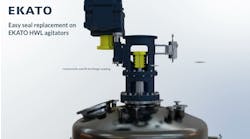Advanced Analytics Proves Its Value
Total Refining & Chemicals, Paris, transforms crude oil and natural gas into finished products or intermediates for making chemicals. Like many companies with global operations, Total is evaluating, testing and deploying advanced analytics technology to gain more insights into its real-time process data. These analytical tools allow the company to quickly discover and diagnose potential issues and help plant workers improve performance.
The adoption of advanced analytics technology fits into Total Refining & Chemicals’ overall digital roadmap for becoming an even-more-efficient data-driven organization. The priorities for this roadmap are: safety, availability, cost control and energy efficiency.
Making the most of advanced analytics requires effectively evaluating in real time the huge volumes of data generated by the thousands of assets and millions of sensors on its sites — in a way that empowers plant personnel to interpret the data themselves.
Total was looking for technologies that made it easy for process engineers as well as plant operations and maintenance personnel to gain actionable insights from their data and quickly diagnose abnormal conditions or potential problems. The company launched a pilot project at its Antwerp, Belgium, site using TrendMiner advanced analytics. The pilot program started in the first quarter of 2016 and ran for one year. The benefits demonstrated during that pilot justified a global rollout of the TrendMiner software to Total Refining & Chemicals’ plants. That rollout began in early 2017.
Advanced Analytics: Pilot Program Objectives
Total decided to pilot an analytics software tool to help get intelligence from its data so employees could quickly determine the cause of process behavior or events. Whenever a problem or abnormal situation occurs in the plant, the operators and process engineers frequently face questions such as: “Has this happened before?” and “Which conditions caused the event?” These types of questions, while common, can be difficult to answer, often requiring extensive and time-consuming data investigations.
The company also wanted to reduce the use of spreadsheets and improve its ability to make sense of day-to-day situations using the analytics software. It needed the following capabilities:
• pattern-based search and discovery;
• fast diagnosis of process behavior and anomalies;
• monitoring live process and asset performance;
• prediction based on historical information;
• analysis of data in real time to enable faster decisions; and
• effective search capabilities, particularly the ability to access sensor and asset information quickly.
To choose the software for its pilot program, Total looked at various types of analytics tools. The company categorized the tools into two categories: generic and operations-specific. The generic tools require both IT development and data scientists or experts, and so are not suitable for direct use by plant staff. In contrast, operations-specific tools are designed to work right out of the box with operations-specific data. Operations-specific tools only require configuration by IT, rather than IT development.
The company also classified the tools by analytics capabilities, namely, their ability to:
• describe (illustrate what has happened based on historical data);
• discover (search historical data to determine what occurred in the past);
• predict (forecast what will happen based on historical data); and
• prescribe (recommend actions a user can take in the future).
In addition, the company required software tools that could combine historical and current data to determine the what, why and how of any issues or events, and that subject matter experts (SMEs) with no special analytics background could use directly on operations-specific data without requiring IT development.
Advanced Analytics: Results Achieved
By combining data and operational reporting from its OSIsoft PI historian with the self-service industrial analytics and data visualization capabilities of TrendMiner, Total was able to meet its requirements. Using the analytics software, process engineers as well as other operations and maintenance personnel can select process tags and search for specific behavior. Data are represented graphically, so users can match patterns, assess against similar events in the past and find correlations quickly. They can compare transitions in batch activities and share the information with everyone needing it.
All data available in the OSIsoft PI historian were used to analyze operational performance. During the pilot, it became clear how easy it was to find similar past behaviors for both anomalies as well as “normal” operation. (When you consider all the interactions with the assets, normal actually means operating within a certain envelope.) With TrendMiner, Total was able to create “golden fingerprints” for similar patterns and use those to define that envelope. Users discovered correlations in the data, shared their findings within the organization and captured them for future use by adding annotations.
The live data become transparent compared to what is considered normal. Once transparent, the user knows whether or not the data are acceptable. For instance, with rotating equipment, loss of efficiency has a large impact on units and power consumption. The software allows for easy calculation of compressor or pump efficiency and plotting as if it were a normal operating parameter.
Because the Antwerp site works with hazardous chemicals, it was essential to integrate machinery and other asset limits and constraints into the data because these cannot be exceeded. Normal operations were based on historical data rather than the information in their specifications. TrendMiner’s pattern-based fingerprinting enables users to select one or more process tags and search the data for similar performance to determine normal or optimal operating conditions. Users then can compare the fingerprinted patterns to live data and benchmark performance within the operating window.
Total’s technology evaluation included a functional assessment and survey of pilot users. The Refining & Chemicals team determined that the OSIsoft and TrendMiner technologies are complementary with little functional overlap. Because approximately 45 users were involved in the pilot, it was important that everyone could use the technology; the power of the data had to go to the people who must interpret those data — operators, plant engineers and other plant workers, not just data scientists.
Total’s assessment gave high scores to the pilot’s self-service capabilities, user friendliness and the tool’s value potential.
The company found that the software can be managed centrally and, as a “plug and play” technology, is compatible with the IT security and landscape. The software enables easy accessibility of the data and intelligence, comes fully programmed and can be configured with agility, allowing users to look at their equipment, troubleshoot and account for each asset separately. Total now can now do more with its data to improve productivity.
Advanced Analytics: Key Takeaways
The pilot showed significant benefits in all four of Total’s industrial priorities: reducing safety risks, improving asset availability, decreasing operational costs and increasing energy efficiency. Additionally, the plug-and-play diagnostics, monitoring and predictive capabilities are expected to bring benefits in areas not yet explored.
The positioning and added value of the software resides in the self-service component of the tool. TrendMiner was built by chemical engineers who know exactly the kind of analysis that must be undertaken on a daily basis. It empowers SMEs — process engineers, technologists, operators and others — by providing a user-friendly tool to analyze, monitor and predict process and asset performance. Users can unlock the power of the industrial data for their day-to-day questions as well as to start long-term projects to improve operational performance — all without the need to involve data scientists.
Not only did the technology reduce the time users needed to diagnose and solve problems, it also improved the ability to share and capture knowledge.
Specifically, the pilot users described the key benefits of the analytics software as:
• Time gain — Obtaining intelligence directly from the system eliminated the time spent going to multiple spreadsheets to diagnose problems.
• Hypotheses testing — The tool allows them to assess potential outcomes of different scenarios.
• Better diagnosis — Users found they could determine the cause of problems faster, send an alert or alarm and preclude potential problems, thus avoiding abnormal behavior.
Total has now added TrendMiner to its digital toolbox for achieving data-driven asset performance.
Advanced Analytics: Next Steps
Based on the success of the pilot, Total Refining & Chemicals will roll out the technology to plants around the world over the next nine months to empower all its SMEs to interpret their own data and make faster decisions. The company hopes to start looking at assets as fleets with standard calculations and key performance indicators and using PI Asset Framework to manage them. In addition, while sites used existing measurement points during the pilot and subsequent rollout, the results of the program have inspired thoughts of adding more-advanced sensors to enable benefiting even more from the analytics.
FABRICE LECLERCQ is a rotating machinery engineer, based in Harfleur, France, for Total Refining & Chemicals. JANICE ABEL is a principal consultant for ARC Advisory Group, Dedham, Mass. Email them at [email protected] and [email protected].

